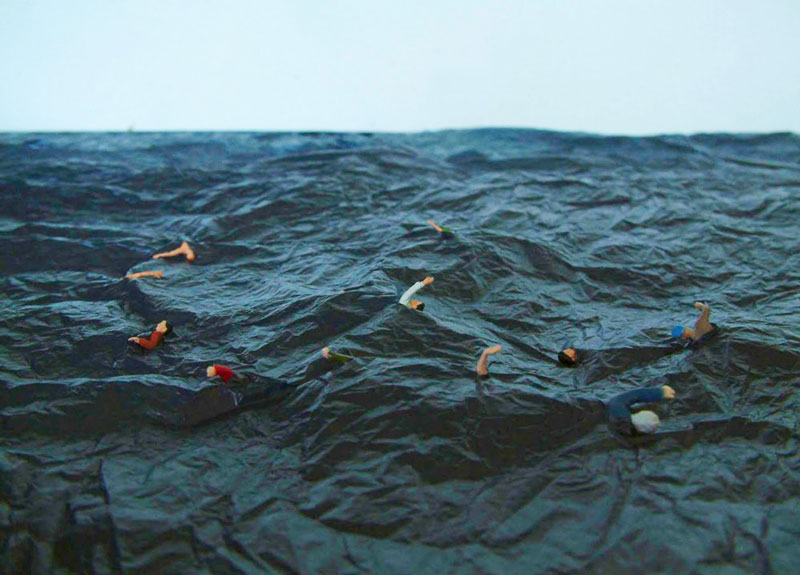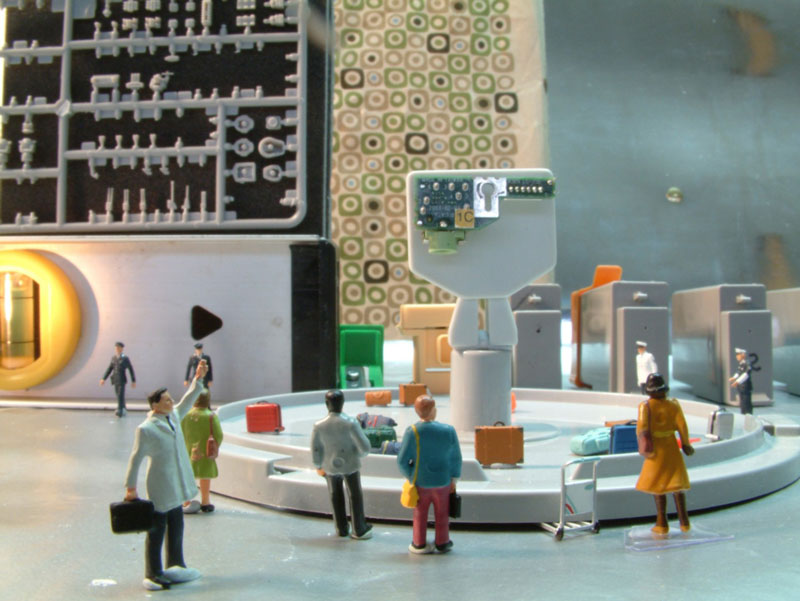Elaine Campaner
1969 – 2020
In memory of Elaine and her wonderful photographic artworks
Gael Newton June 2022
 |
Those Who Swam (SiIEV X) 2008, purchase from the exhibition of Internment series, Sydney 2009
Originally part of our collection. In 2015 it was none of the artworks by women photographers donated to the Bendigo Art Gallery |
I first became acquainted with Elaine Campaner’s art through a group of small colour prints from her 1999 Mice series. These were included in the showing of private collector Peter Fay’s multimedia collection at the National Gallery of Australia in 2004 under the title Home Sweet Home. The collection was subsequently acquired by the Gallery.
Elaine’s mice fitted the ironic title of the Fay collection show perfectly. They were real but dead and stillborn creatures staged in tableaux of small toys in a domestic setting.
It hit me in the eye that this artist was brave and bold and had a world view of her own that was ostensibly playful on one level, deadly serious politically and socially and spiritually on another. The works were not ‘women’s home craft’ but sophisticated and critically informed. It seemed also at that time and still today, that it has been women photographers since the 1970s that have addressed issues that threaten the world and deny justice.
Elaine would go onto make ever more ambitious, ingeniously staged works using un-disguised household props addressing major topical issues as well as deeply personal ones.
When we look at Elaine’s work we willingly suspend our disbelief as we puzzle out the various levels of meaning in her universe. Hopefully we take home enough to change our views or have empathy for others as a result.
Very few artists or poets ever spell out what message or emotion we should take away as viewers. Nor do we overly concern ourselves with how an art work was made although poor execution is always conceptually wanting. Elaine Campaner made enigmatic works some with overt political meanings most open to multiple readings depending on the receiver.
Elaine Campaner’s depicts her ‘atlas mundi’ or world view in miniature tableaux using small scale domestic objects and materials. She was truly brilliant at it.
Assemblage artists in all media share a cognitive ability to disassociate the familiar into what else it’s shape or texture evokes. The large colour photographs are beautiful in themselves as prints but depend on the exquisite choreography of textures and lustrous surfaces in each tableaux. Tissue papers for eg become a lunar landscape or sea. There is an initial gear change as we recognise the figurines and disassembled objects recast in a tableaux that might have overt political or social reference or be a touchstone to shared experiences or be mysterious surreal and otherworldly. Campaner recognised the role that the associations we bring to the objects is an essential part of the response
I am interested in how 'retro' objects can invoke a strange regression based on childhood associations, and why this is a form of aesthetic sensation - often the involuntary aesthetic pleasure of jouissance
As time passes the objects we immediately recognise from their former function may be unfamiliar to a future generation but the image created will have a life of its own.
Campaner considered herself a painter. She could have just painted, sculpted or photographed equally imaginary worlds. Assemblage however, was not simply a means to an end. The materials held their own aesthetic and conceptual meaning. As Campaner wrote
I use the material stuff of life as literal or conceptual signifiers. The uncertainty of what you are looking at literally and representationally enables visual and conceptual complexity.
The viewer often has a sense of being outside the scene and spaces of a doll’s house. We zoom from microcosm to macrocosm, the everyday to the global. Campaner’s commentaries on her exhibitions show the depth and range of her how there are;
Multiple and reoccurring themes in my work, including Australian post-colonial identity and migration; refugee migration; the gap between the projected and the actual; the cultural hegemony of mining and energy companies; and the impact on the environment as we produce and produce and consume and consume in search of an ever receding and ideal ‘place in the sun’
Among the early works are two Barbie blokes re-costumed as St John the Baptist coming out of the desert retreat with his sustenance of honey and locusts and Jesus Christ as the Good shepherd. They stride forward confident of their message for the world matching the sanitised child’s bible version of religion. Just believe and you’ll be saved – adults know it’s not that simple.
Later works mostly moved away from close encounters with single figures. Puny humans seem distracted by the world of baggage carousels (many know that scenario) and stock exchanges anxieties. Paradise is illusory. Some scenarios have seemingly overt political overtones, figures punished by their fellows are interned or abandoned. These images reflect the misery of institutional power over vulnerable people.
A tiny refugee boat tries to breach the 100% white Australian border, others jostle and jump up to be taken in as refugees. Even leisure is shallow tourists at the mysterious and sacred mound of Uluru are absorbed in their own world.
Several of Elaine Campaner’s works lived with me for some years but were dutifully donated to collections to be pondered and absorbed other viewers. One later major work remains treasured. As with all theatre naturalism and realism and surrealism can happily co exist and collaborate. Campaner’s images address sombre themes or question shallow distractions but their beauty is also redemptive and inspiring.
 |
| Airport |
see also: On Our Collections, Lake 2017
more of Gael Newton's Essays and Articles
|